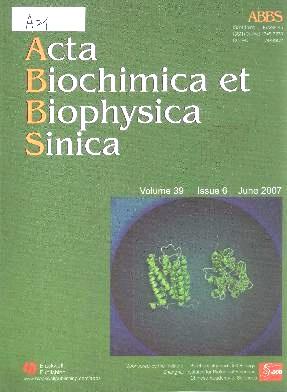miR-155通过sirtuin 1/核因子-κB介导的肠道脓毒症诱导脓毒症相关的肠粘膜屏障损伤。
IF 3.3
2区 生物学
Q2 BIOCHEMISTRY & MOLECULAR BIOLOGY
引用次数: 0
摘要
败血症是一种危及生命的器官功能障碍状态,由全身炎症和对宿主感染的功能失调反应引起,可诱发严重的肠粘膜损伤。脓毒症期间,在各种炎症因子的刺激下,活化的 NOD 样受体家族含 pyrin 结构域的 3(NLRP3)炎性体介导了裂解。炎症反应是败血症期间肠道损伤的主要驱动因素。脓毒症时肠粘膜屏障功能障碍与一种程序性炎症细胞死亡--脓毒症有关。多项研究证实了 miR-155 在败血症和其他疾病中的作用。然而,miR-155 在败血症期间肠粘膜屏障功能障碍的背景下对肠道脓毒血症的影响仍不清楚。因此,本研究利用盲肠结扎和穿刺术(CLP)建立了 Sprague-Dawley 大鼠败血症模型,并采用了一系列分子生物学方法。结果表明,脓毒症患者肠道组织中 miR-155 的表达增加,sirtuin 1(SIRT1)的表达减少,miR-155 的表达与 SIRT1 的表达呈负相关。miR-155 表达的增加会明显抑制 SIRT1 的活性,并上调 NOD 样受体家族含 pyrin 结构域的 3(NLRP3)、caspase-1、含 CARD 的凋亡相关斑点样蛋白(ASC)、白细胞介素-1β(IL-1β)和白细胞介素-18(IL-18)的表达,从而促进脓毒症的发生。抑制 miR-155 的表达与 SIRT1 的表达增加有关,可促进 p65 的去乙酰化,并显著下调 p65 的乙酰化。在此,我们提出,miR-155 部分通过调节 SIRT1 来诱导肠道内的脓毒症,从而降低脓毒症中核因子(NF)-κB 亚基 p65 的去乙酰化,增加 NF-κB 信号活性,导致肠屏障损伤。本文章由计算机程序翻译,如有差异,请以英文原文为准。
miR-155 induces sepsis-associated damage to the intestinal mucosal barrier via sirtuin 1/nuclear factor-κB-mediated intestinal pyroptosis.
Sepsis is a life-threatening state of organ dysfunction caused by systemic inflammation and a dysfunctional response to host infections that can induce severe intestinal mucosal damage. Pyroptosis is mediated by the activated NOD-like receptor family pyrin domain-containing 3 (NLRP3) inflammasome after stimulation by various inflammatory factors during sepsis. The inflammatory response is a major driver of intestinal damage during sepsis. Intestinal mucosal barrier dysfunction in sepsis is associated with pyroptosis, a type of programmed inflammatory cell death. Several studies have confirmed the role of miR-155 in sepsis and other diseases. However, the effect of miR-155 on intestinal pyroptosis in the context of intestinal mucosal barrier dysfunction during sepsis remains unclear. Thus, a model of sepsis in Sprague-Dawley rats is established using cecal ligation and puncture (CLP), and a series of molecular biological methods are used in this study. The results show that the expression of miR-155 is increased and that of sirtuin 1 (SIRT1) is decreased in the intestinal tissues of patients with sepsis. miR-155 expression is negatively correlated with SIRT1 expression. Increased miR-155 expression significantly inhibits SIRT1 activity and upregulates the expressions of NOD-like receptor family pyrin domain-containing 3 (NLRP3), caspase-1, apoptosis-associated speck-like protein containing a CARD (ASC), interleukin-1β (IL-1β) and interleukin-18 (IL-18) to promote pyroptosis. The inhibition of miR-155 expression is associated with increased SIRT1 expression, promotes the deacetylation of p65, and significantly downregulates p65 acetylation. Herein, we propose that miR-155 induces pyroptosis in the intestine partly by regulating SIRT1, thereby reducing the deacetylation of the nuclear factor (NF)-κB subunit p65 and increasing NF-κB signaling activity in sepsis, leading to intestinal barrier damage.
求助全文
通过发布文献求助,成功后即可免费获取论文全文。
去求助
来源期刊

Acta biochimica et biophysica Sinica
生物-生化与分子生物学
CiteScore
5.00
自引率
5.40%
发文量
170
审稿时长
3 months
期刊介绍:
Acta Biochimica et Biophysica Sinica (ABBS) is an internationally peer-reviewed journal sponsored by the Shanghai Institute of Biochemistry and Cell Biology (CAS). ABBS aims to publish original research articles and review articles in diverse fields of biochemical research including Protein Science, Nucleic Acids, Molecular Biology, Cell Biology, Biophysics, Immunology, and Signal Transduction, etc.
 求助内容:
求助内容: 应助结果提醒方式:
应助结果提醒方式:


